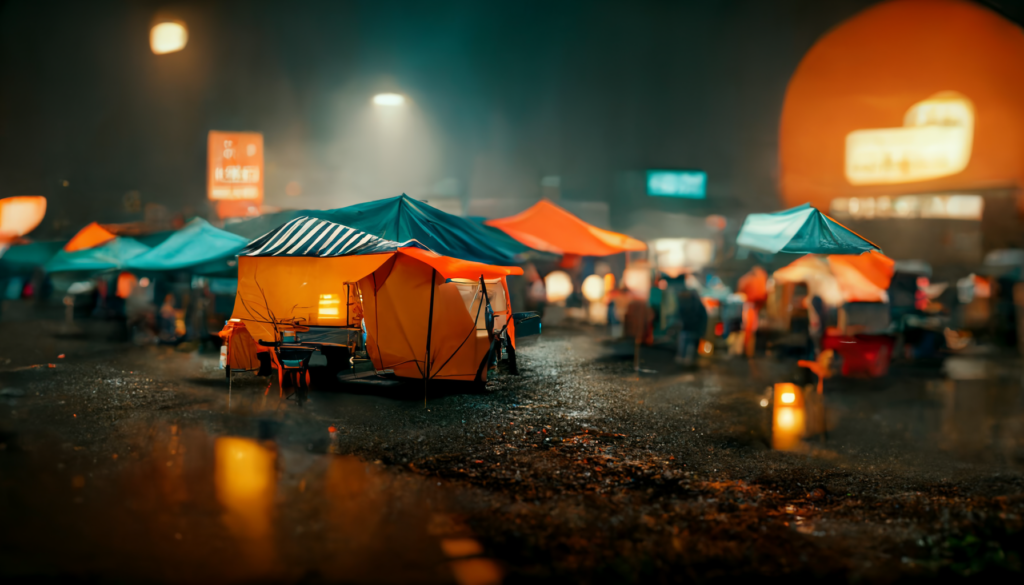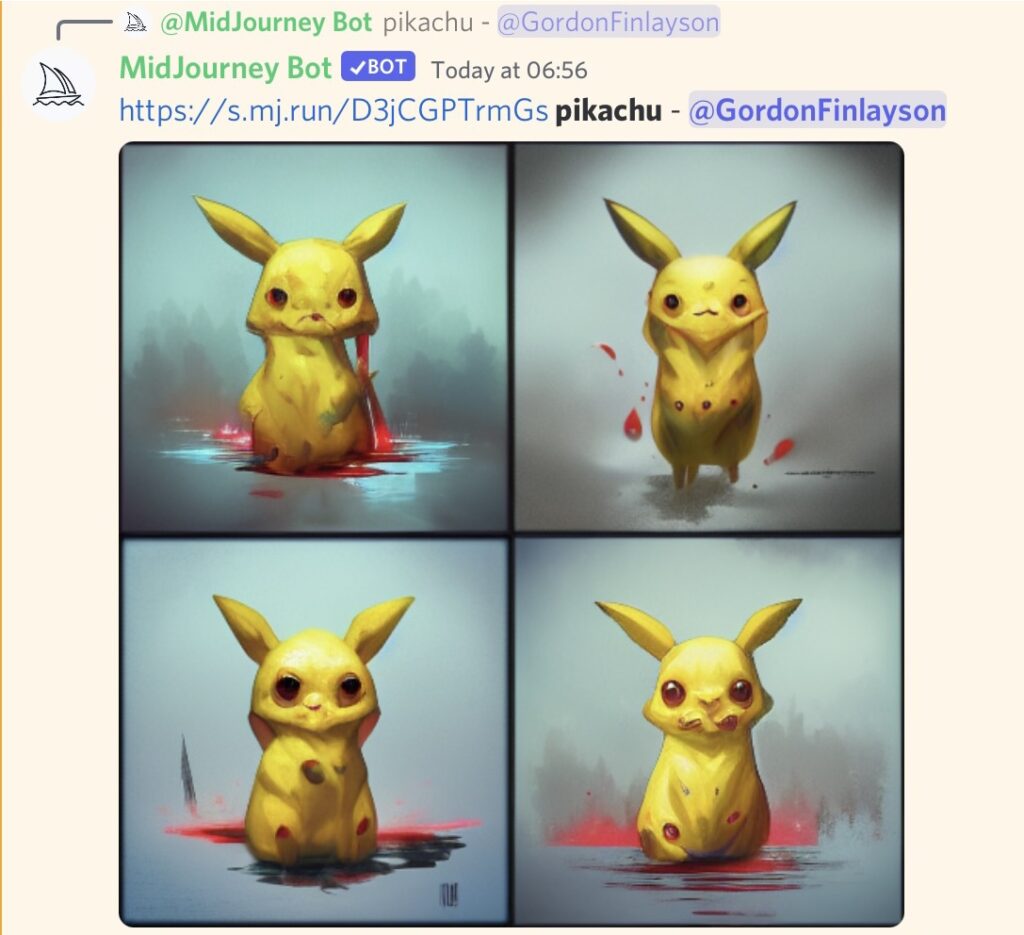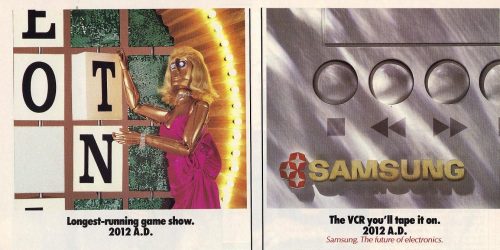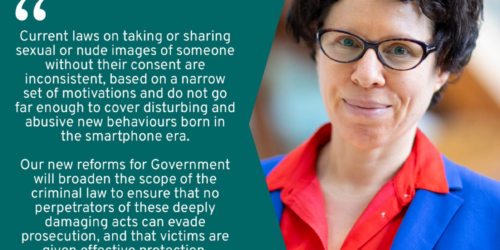Midjourney – Testing the Boundaries of Art, AI and the Law
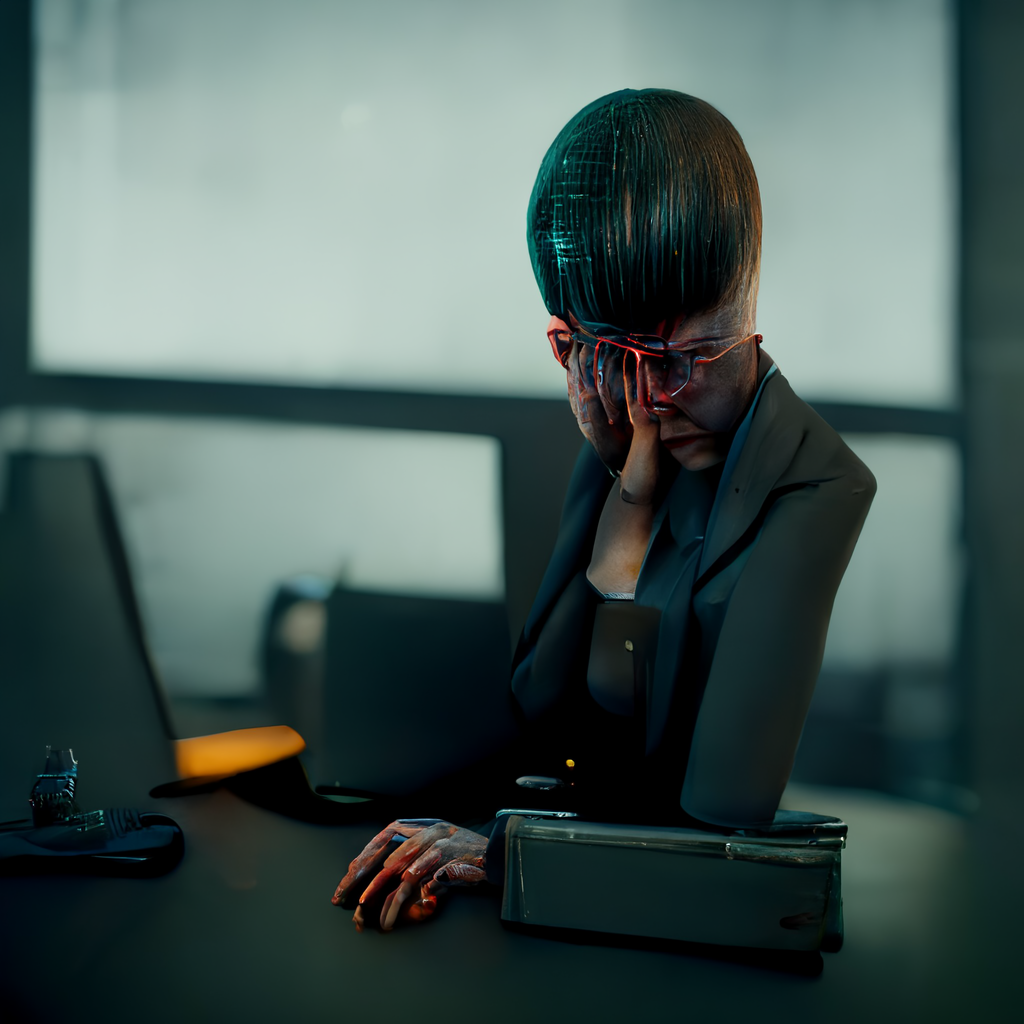
The Future for Creative Industry Workers, by Midjourney
The recent advent of compelling new AI driven image generation services, including OpenAI’s Dal-EE and MidJourney is signalling a profound transformation in the creative economy.
Over recent years, AI image generators have developed from interesting curiosities to the point that they can now mimic highly specialised human artistry, producing images that rival the technical quality of human illustrators or artists in the space of seconds.
The advent of MidJourney and similar services raises a host of novel legal issues, particularly around IP ownership, the creation of derivative works, passing off, personality rights, trade mark infringement, free speech and online abuse.
Snapshot: Key Legal Issues For Midjourney
- Simultaneous image generation and publication via a public form places direct liability on Midjourney (as well as the user) for potential IP infringement.
- Midjourney potentially infringes on the personality and trade mark rights of specific artists by allowing for the creation of images ‘in the style of’.
- Uses copyrighted works as source material for the creation of new artworks without consent or compensation.
- Potential infringement of trade mark and personality rights by operating a service that creates and publishes of images of persons, brand names and logos;
- Midjourney AI facilitates the creation and publication of copyrighted works which could be regarded as derivative without license or compensation.
- Limited filters or moderation may result in the service being used for harassment, defamation or hate speech.
What is an AI Image Generator?
AI Image Generators such as Midjourney are programs that apply machine learning to text descriptions of massive data sets of images, allowing the AI to learn how to identify and categorise stylistic and thematic elements of existing images such as paintings, photographs and renders. The AI Image Generator then uses this database in order to produce new images that synthesise the information gathered through the machine learning process to create entirely new images.
With Midjourney pictures are generated based on a collection of natural text commands. For example, the picture below was generated in a matter of minutes, using the description “night market on the road at the night, the warm light is on inside, it’s raining outside, teal & orange style, cinematic composition, landscape…”
The above image (what Midjourney calls an “Asset”) demonstrates the surprising potential of AI driven artworks, where the Midjourney created, in the space of minutes, an image that otherwise would have taken a highly skilled and specialised illustrator hours to compose.
Midjourney’s creative output is delivered through the medium of the Discord social media and messaging platform. Users log in to specific servers and request image generation through text commands that are proceeded by a /image command line.
Image requests are conducted in an entirely public manner, with your Asset appearing in a stream alongside those of other users, a dreamlike parade of images of varied subjects and styles constantly updated by users throughout the world.
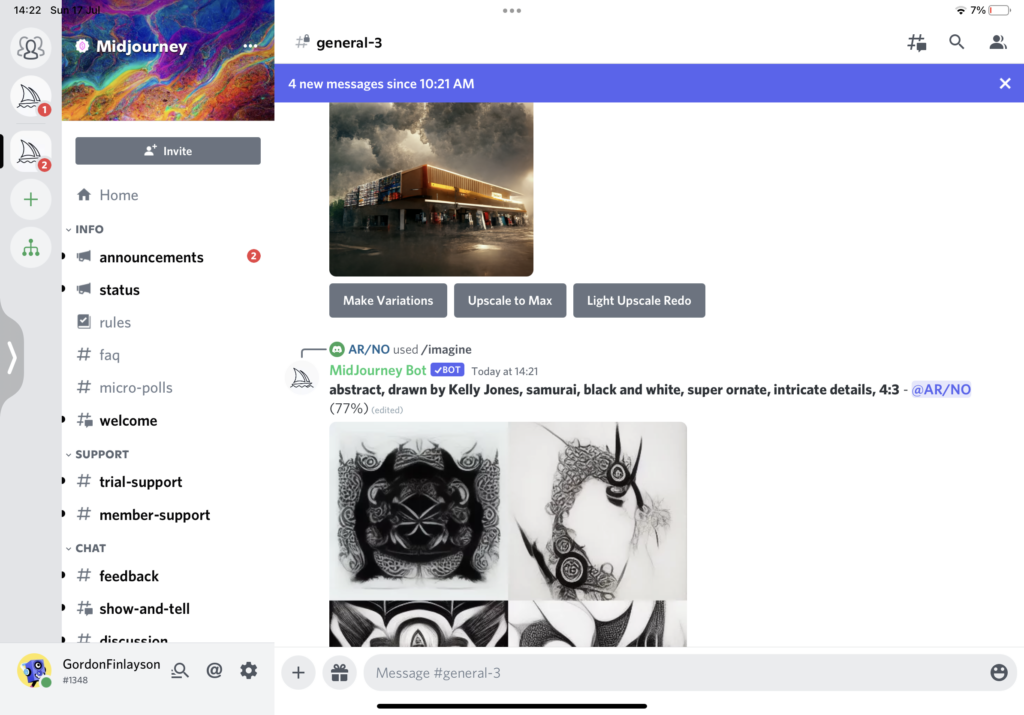
Midjourney has upended the creative process, by taking what was previously a time consuming, highly skilled, private and exclusive process and turning it into a creative assembly line where highly sophisticated artworks are created at a breakneck speed by at the direction of neophytes in a public forum on a largely non-exclusive basis (further detail on that below).
It is notable that Midjourney is not simply a lab testing out AI image generation software, it is a commercial service, with basic subscriptions being sold at around $10 per month, with higher rates increasing for private, high volume and corporate packages.
IP Rights
Ownership in the copyright of the in the Assets created by the AI is one of the most obvious legal questions to address. The Midjourney Terms of Service state that “…you own all Assets you create with the Services” yet this is subject to a major caveat – that you, in return, grant Midjourney a near unlimited license to use the Asset as well. The grant of license users provide to Midjourney is specified as:
…perpetual, worldwide, non-exclusive, sublicensable no-charge, royalty-free, irrevocable copyright license to reproduce, prepare Derivative Works of, publicly display, publicly perform, sublicense, and distribute text, and image prompts you input into the Services, or Assets produced by the service at your direction.
So while you may be able to own and use images created using Midjourney, anyone using the service can remix your images and create copies for their own use (unless the user subscribes to a private plan) as noted in the T&C:
Midjourney is an open community which allows others to use and remix your images and prompts whenever they are posted in a public setting. By default, your images are publically viewable and remixable. As described above, you grant Midjourney a license to allow this. If you purchase a private plan, you may bypass some of these public sharing defaults.
So there are major limitations on the ownership rights conferred by Midjourney, rights that are likely to be even more limited under Copyright law in the event that your work uses the IP rights of others, potentially creating a Derivative Work.
Are Midjourney Assets Derivative Works?
For existing creators and rights holders, Midjourney poses a massive competitive threat, and the model raises significant questions concerning the use of existing IP in order to create the Assets.
For example, it would appear that the use of existing copyrighted materials is integral to the Midjourney’s creation of new Assets. As such there seems a reasonable argument that to a greater or lesser extent, depending on the context that Midjourney is actually creating Derivative works.
The US Copyright Act broadly defines a “derivative work” as a work based upon one or more preexisting works, such as a … any other form in which a work may be recast, transformed, or adapted.
In testing Midjourney I found few restrictions on the images that could be created, major fictional characters such as Pikachu, Mickey Mouse, Boba Fett or Anna from Frozen all immediately generated images. Such characters are protected by both copyright and trade mark law and as such the creation and publication of new images based on these characters would appear to infringe the rights of the copyright / TM owners.
Any user of Midjourney that creates a work based on the IP of another is likely to have limited legal rights to exploit the work under Copyright law. While this is not unlike the current situation when illustrators create fan art the social and public nature of Asset creation may have created additional liabilities for Midjourney itself.
By using the Discord social media messaging platform for the creation and distribution of Assets Midjourney is not only creating, but also publishing Derivate Works owned by other Copyright owners. The publication of artworks in public on the Discord platform creates significant additional liabilities for Midjourney, since it stops being a simple tool to create images and becomes a publisher, with the attendant responsibilities concerning content moderation, defamation, obscenity, hate speech, and copyright and TM infringement .
If Midjourney used a database of publicly available Copyrighted materials as the source material for the machine learning process, and in doing so potentially reproduced the images or data associated with the images in order to train its AI to create Assets, then there is an additional argument that the entire data set is tainted by the unauthorised copyright infringement.
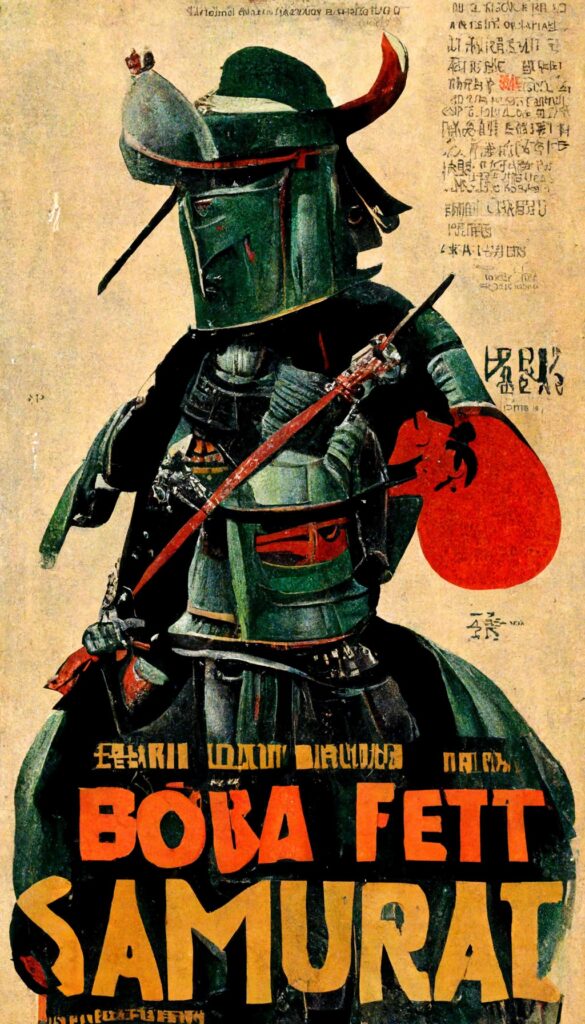
Boba Fett as a Vintage Samuri by Midjourney
Machine Learning Based on Copyright Infringement?
Existing data sets of images are crucial to the process of creation of AI Image Generators, without which the AI is unable to systematically understand and categorise the subject matter, styles and visual elements.
If copyrighted images were used without a license then and reproduced or adapted without consent then such process may constitute a breach of the exclusive rights of copyright holders.
Based on descriptions of the process in the media (see an excellent background article from Vox here), it would appear that Midjourney was trained with data sets of images and their accompanying text descriptions scraped from the Internet. While the process of simply viewing images across the Internet is unlikely to exceed the threshold for copyright infringement, if that process necessarily involved some form of reproduction of the images then there may well be an argument for infringement.
Midourney functionality demonstrates that the software continues to use third party images as reference sources, even providing users with the ability to reference specific images by url in the creation of new works.
For example, Midjourney will allow users to produce new images based off the image located at a specific URL. In order to test this process, I asked Midjourney to produce an image based on the Shepard Fairey illustration “We The People” but with the woman replaced by Tom Hanks.
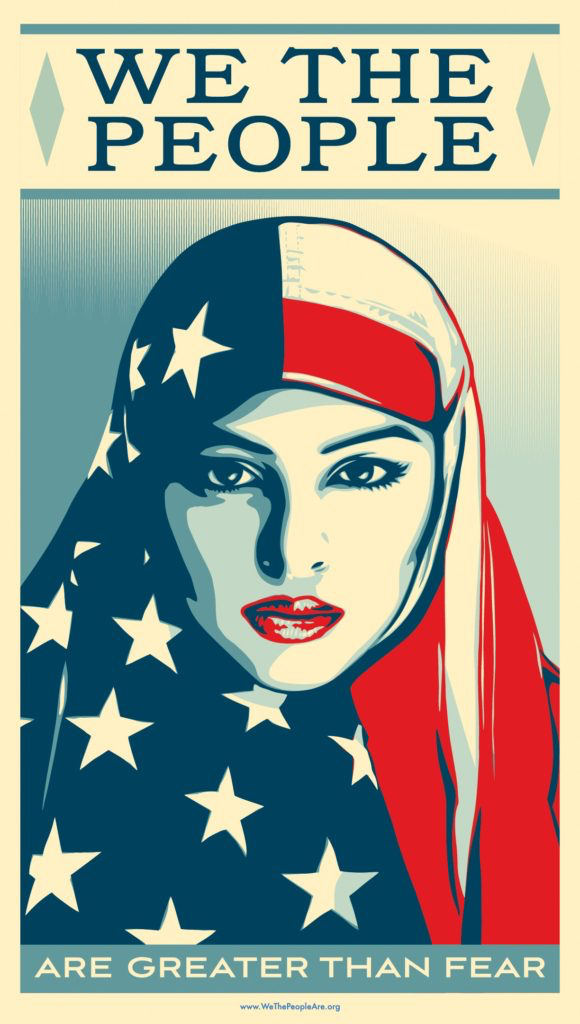
Shepard Fairey’s “We The People” 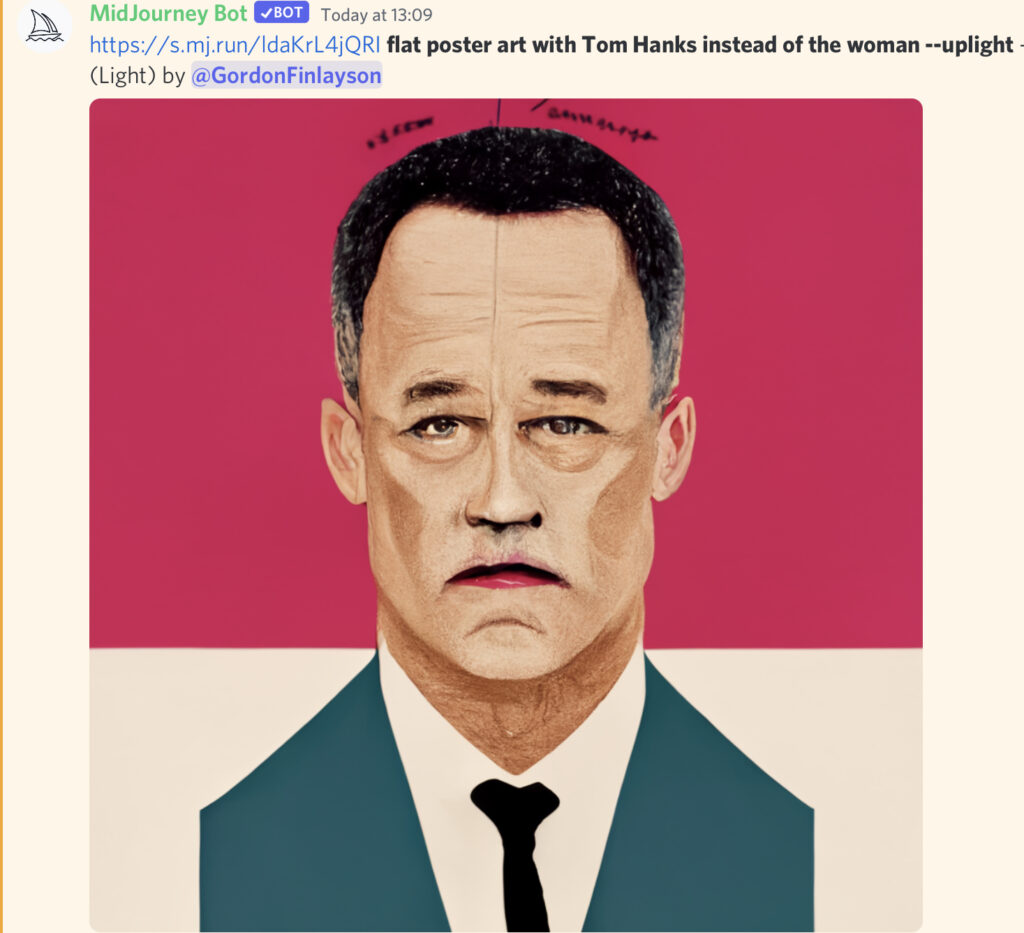
Midjourney’s “We the People” with Tom Hanks
Putting aside the limited similarities between the images, the mere fact that Midjourney provides functionality that allows new images to be created based on the existing URLs points to a seemingly clear case of copyright infringement where the AI ispecifically creates and publishes a derivative copyright work without consent.
Personality Rights, Trademark Rights and Passing Off
Another highly contentious aspect of Midjourney AI is that the system allows for the creation of Assets in the style of specific named artists, such as the example above where a new picture is derived based on a specific artwork from renowned illustrator and artist Shepard Fairey.
Providing functionality that specifically allows for the generation of artworks based on the name of the artist provides a clear paper trail to demonstrate the artwork is in fact a derivative work under Copyright law.
By using the name of specific artists in the creation of specific images, Midjourney also infringes on the trade mark and personality rights of those artists (or their estates).
Since Midjourney also allows for the creation of images and text featuring a wide range of public figures, it further risks infringement of the trade mark and personality rights of the subjects of the pictures as well as the artists styles used to create the Asset.
In order to test this further, I asked Midjourney to create Assets of a Harry Styles album cover in the style of Shepard Fairey and a Metallica album cover in the style of Norman Rockwell, see below.
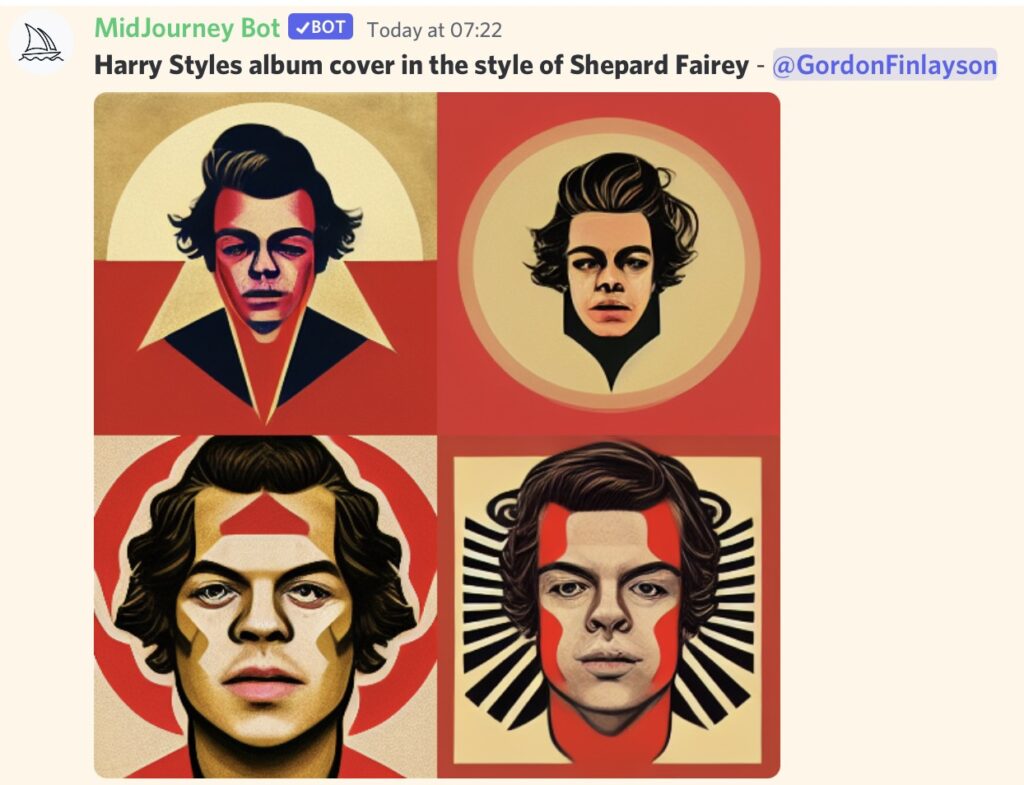
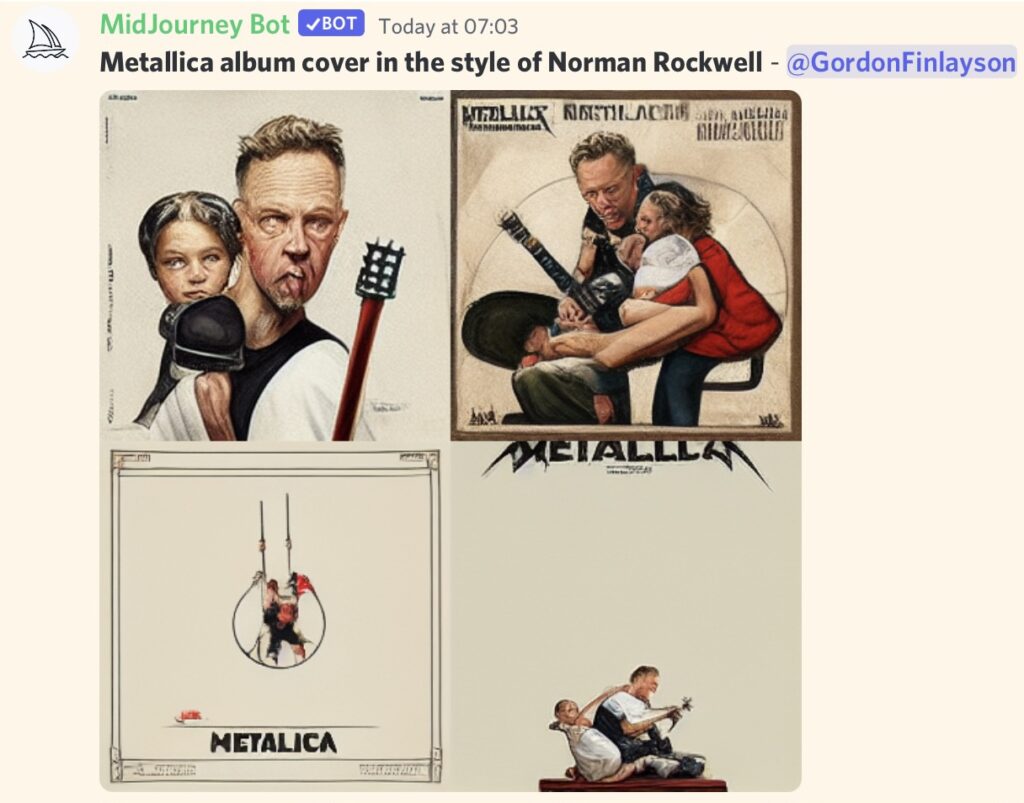
There is a reasonable argument that the creation and publication of these images by Midjourney constitutes a breach of (a) Copyright; (b) Personality rights and/or (c) the Trade Mark rights of Harry Styles, Shepard Fairey, Metallica and the estate of Normal Rockwell.
Wilful Infringement
Where addressing the issue of derivative works and the exploitation of artist names, copyrighted materials and styles, Midjourney seems to invite invite a claim of wilful infringement under the US Copyright Act.
Wilful infringement requires that a defendant knew that they were engaging in acts that infringed copyright and did so with reckless disregard or wilful blindness to the copyright owner’s rights. Further the lack of clear processes to exclude an artists name or works from use by the service would seem to lend towards an argument of reckless disregard for the rights of copyright owners.
Each act of Wilful Infringement could result in the application of statutory damages, at $150,000 per infringement, and given the volume of requests on the service a successful claim in this area would be likely to shut it down quickly.
Infringement of Moral Rights?
In another significant respect the Moral Rights of Copyright owners may also be infringed by the publication of Midjourney Assets.
Moral Rights protect the author’s rights in their works even following the sale or disposal of the rights. While Moral Rights are not enshrined in law throughout the world, they are established in most countries in Western Europe in accordance with the Berne Convention, which provides authors the right to:
“object to any distortion, modification of, or other derogatory action in relation to the said work, which would be prejudicial to the author’s honor or reputation”.
Harry Potter wielding a Glock firearm as below is just one fairly benign example that I observed on Midjourney, I also observed a range of other Assets being created that may have been considered a derogatory to the author’s honour or reputation.
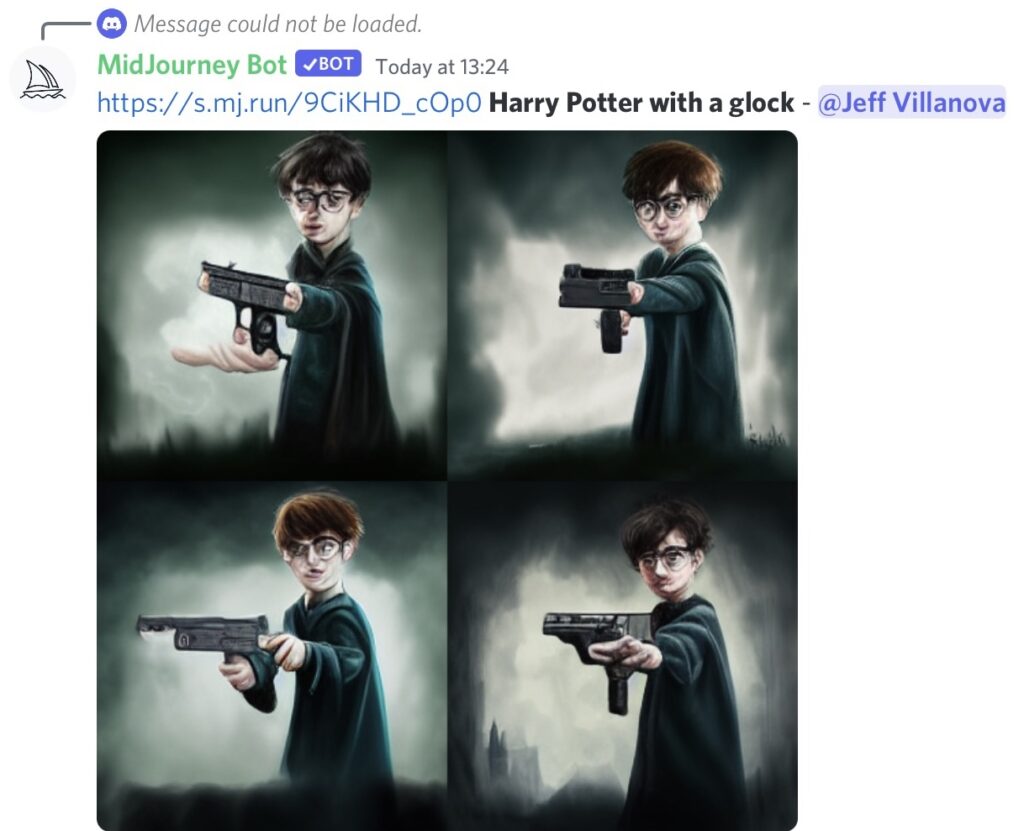
Hate Speech, Defamation and Harassment
Testing the boundaries of what could be created by Midjourney I found that there are a number of words which are blocked by the service. The Terms of Service for Midjourney note that the following limitations:
Do not create images or use text prompts that are inherently disrespectful, aggressive, or otherwise abusive. Violence or harassment of any kind will not be tolerated.
No adult content or gore. Please avoid making visually shocking or disturbing content. We will block some text inputs automatically.
Terms such as ‘Adolf Hitler’ and “Ku Klux Klan” were blocked automatically by the system, however the list of banned terms seems to be fairly limited and moderation lax, leaving the system wide open for misuse. For example “Ronald McDonald as the Devil” returned the following disturbing images:
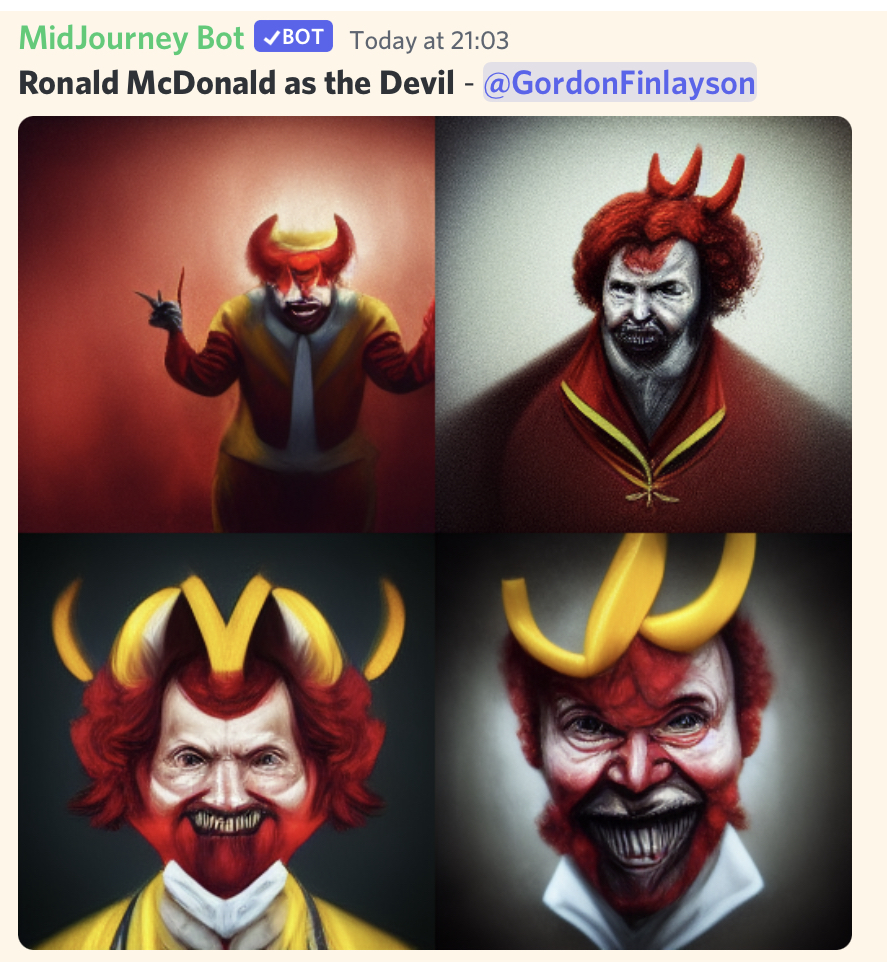
Disclaimer: the the author does not mean to imply the existence of a satanic conspiracy between the world’s largest fast food chain and the lord of Hell. Yet the example is illustrative of the potential for misuse of AI image generators for harassment, slander or deepfakes.
I tested the same example on Midjourney using of actual real life public figures each which returned an equally disturbing results. The creation and publication on Discord of such images could potentially exceed the threshold for defamation or harassment in many jurisdictions and as such creates legal risks for both users who might engage in such conduct, but crucially also the platform itself.
The architecture of Midjourney within a social network where the distribution and publication of AI created Assets is intrinsic to the platform creates one of the most significant legal issues. If Midjourney only created and distributed images to individuals privately then the much of the liability for publication and distribution of images that are derivative, offensive or defamatory would be placed back onto the user (should they choose to publish the image).
Wrap-Up
Midjourney and similar products are truly transformative and mark a new phase in the evolution of machine intelligence and AI. How the law responds to these challenges will be important in order to create a balance between the rights of existing rights holders while facilitating an environment that fosters new technological innovation.
There are numerous serious legal questions that have arisen from operating model and architecture of the Midjourney AI. The undeniable disruption that already is occurring as a result of Midjourney will incentivise major rights holders who face a competitive or reputational threat from the service (Getty, Shutterstock, Adobe, Disney, Netflix, Viacom) to enforce their rights through the courts in order to reign in the more egregious breaches of their rights.
AI Image Creators and the technical innovations that will follow in the years to come are an exciting development in the creative industries and will facilitate the growth of new and novel forms of artistry. But it is crucial that such technological development does not come at the expense of those artists that were integral to the creation of the AI in the first place.
Midjourney would be well advised to take note of the legal concerns at this stage and put in place a new business model and advanced moderation and artist filtering before the courts step in and render the model uncommercial through the application of statutory damages.

